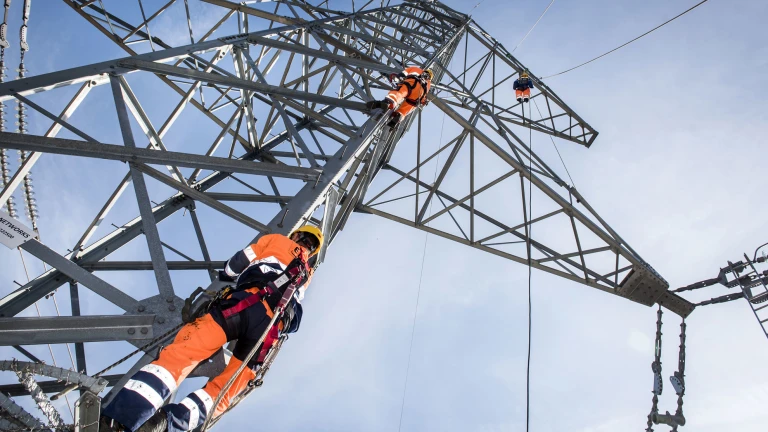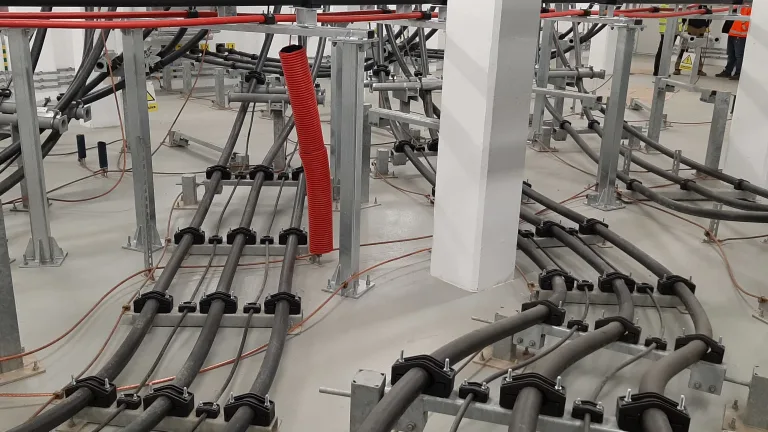
Offer
Power lines
LV, MV, HV power lines – what is it and how does it work?
Power lines are key elements of transmission and distribution systems in the National Power System, which enable the transmission of electricity over long distances. There are different types of power lines, including LV, MV and HV, with different design features, technical requirements and applications. Alterga deals with their safe and professional construction, taking care of sustainable development, health protection of our employees and the highest quality of workmanship.
Low voltage power line, LV – means low voltage and is used in power grids to transmit electricity with a voltage of up to 1 kV.
Medium voltage power line, MV – means medium voltage and is used in power grids to transmit electricity with a voltage of 1 kV to 35 kV.
High voltage power line, HV – means high voltage and is used in power grids to transmit electricity with a voltage of 35 kV to 110 kV.
Highest voltage power line, HV – means the highest voltage and is used in power grids to transmit electricity with a voltage above 110 kV.
Division of power lines into overhead and cable
There are two basic types of power lines: overhead lines and cable lines. As Alterga, we design, build and modernize overhead power lines in the scope of: implementation of investments in the “turnkey” system, implementation of investments in the “build” system for entire facilities or their separate parts, construction, reconstruction, modernization of overhead lines of all voltage levels (MV, 110 kV, 220 kV, 400 kV, 750 kV) in particular: execution of groundings and foundations for poles, assembly and erection of lattice, tubular and pre-stressed concrete poles, anti-corrosion protection of poles’ surfaces, installation of the necessary line equipment, chains, insulators, assembly and adjustment working wires, lightning conductors and OPGW, removal of collisions and implementation of intersections with the existing infrastructure.
Overhead power lines are built on lattice, tubular or pre-stressed concrete poles which are placed along the route of the line. The wires are taut on insulators that prevent current from flowing through the poles. Cable lines are laid underground or in underground corridors, most often in urban areas.
Overhead lines are more popular and cheaper to build, but when the temperature rises, the wires sag, which poses a real threat to the safety of bystanders.
As part of works on cable lines, Alterga offers the implementation of investments in the “turnkey” system, in the “build” system, construction of 110 kV, 220 kV and 400 kV cable systems, excavation and laying of cable routes, construction of fibre optic routes, full measurements and commissioning of MV cable lines and cable systems, excavation and laying of medium voltage cable routes, installation of interior and overhead medium voltage cable joints and cable heads.
Cable lines are a solution that is much more expensive to build, but it provides more security for bystanders, does not negatively affect the landscape, and due to the fact that it does not take up space above the ground, it is less burdensome for the environment. The operation of cable lines is less invasive for the environment, because it does not require regular cutting of trees in forest areas. In addition, the power supply stability in the case of cable lines is usually better, which gives better reliability of power energy network.
Selection of the wire cross-section taking into account key aspects
In the process of selecting the cross-section of power line wires, it is necessary to take into account many important aspects, such as supply voltage, line distance, number of consumers, type of transmitted energy, as well as the specificity of the power industry in a given region.
Variety of cross-sections of power line wires
Power line wires can have different cross-sections, which depend on the power transmitted through the network. As the cross-section of the wire increases, its transmission capacity increases, which enables the transfer of larger amounts of energy. In addition, the larger cross-section of the wire helps to reduce the energy loss that results from the resistance of the wire. In the case of cables with a smaller cross-section, energy is lost in the form of heat, which negatively affects the efficiency of the energy transfer process.
Power line construction
The choice of power line construction depends on the specific design requirements and site conditions. Designers can choose from many types of poles with various applications, which are selected depending on the individual needs of the project.
Lattice poles
Lattice poles are often used for their strength and flexibility. Thanks to the construction based on trusses, the poles can withstand heavy loads, while being relatively light and easy to assemble. Lattice poles can support HV and MV power lines.
Tubular poles
Tubular poles can be constructed at different heights and be adapted to specific needs. For example, by using poles with height between 49 and 56 meters, the so-called over-forest system, which eliminates the risk of damage to the line by falling trees or breaking off branches. Trees and branches are not cut down in such areas to maintain a safe distance from power lines. Tubular poles are corrosion resistant and easy to maintain. Tubular poles can support LV, MV or even HV power lines.
Pre-stressed concrete poles
Pre-stressed concrete columns are made of pre-stressed concrete, which makes them extremely durable and resistant to wind and related loads. They are especially used in places where there are strong winds or weather conditions requiring higher structural strength. Pre-stressed concrete poles are also corrosion resistant and have a long service life.
Earthing and foundations for power line poles
Earthing and foundations for power line poles are crucial to ensure the stability and safety of the entire structure. Earthings protect against electric shock in the event of a short-circuit, while the foundations guarantee the unshakable position of the poles.
Types of poles’ foundations
The foundations of power line poles can be made of various materials, e.g. concrete and steel. Their design should take into account the appropriate strength and stability of the structure, as well as ground conditions and wind loads.
Anti-corrosion protection of pole surfaces
Protecting the surface of poles against corrosion is important to ensure the long-term operation of power lines. The poles are exposed to the influence of atmospheric conditions, which may contribute to the acceleration of the corrosion process. Corrosion protection can include various methods, such as painting, galvanizing or the use of specialized protective coatings.
Installation and adjustment of wires
Installation of wires on power line poles requires precision and the use of specialized equipment. The wires are mounted on the insulators and then tensioned using a suitable device. It is important to ensure proper cable tension, which directly affects the stability of the entire structure.
Wire adjustment is the process by which the tension of the wires is changed to maintain their correct position on the poles. Adjustment is necessary due to temperature changes that can affect wire length and cause sagging or displacement. Please note that incorrect cable tension can lead to damage.
Removal of conflicts and implementation of intersections with existing infrastructure
During the construction of power lines, it may be necessary to route the installation through roads, rivers, wooded areas and other existing infrastructure elements. In such a situation, it is necessary to make special structures that will enable safe crossing of the obstacle.
Conclusion
Alterga is a reliable partner for the energy sector, providing comprehensive services and having professional competence at every stage of the investment. We are distinguished by modern and specialized equipment, international projects and over 60 years of experience. We believe that safety and the use of innovative solutions in power engineering construction are the most important aspects.

